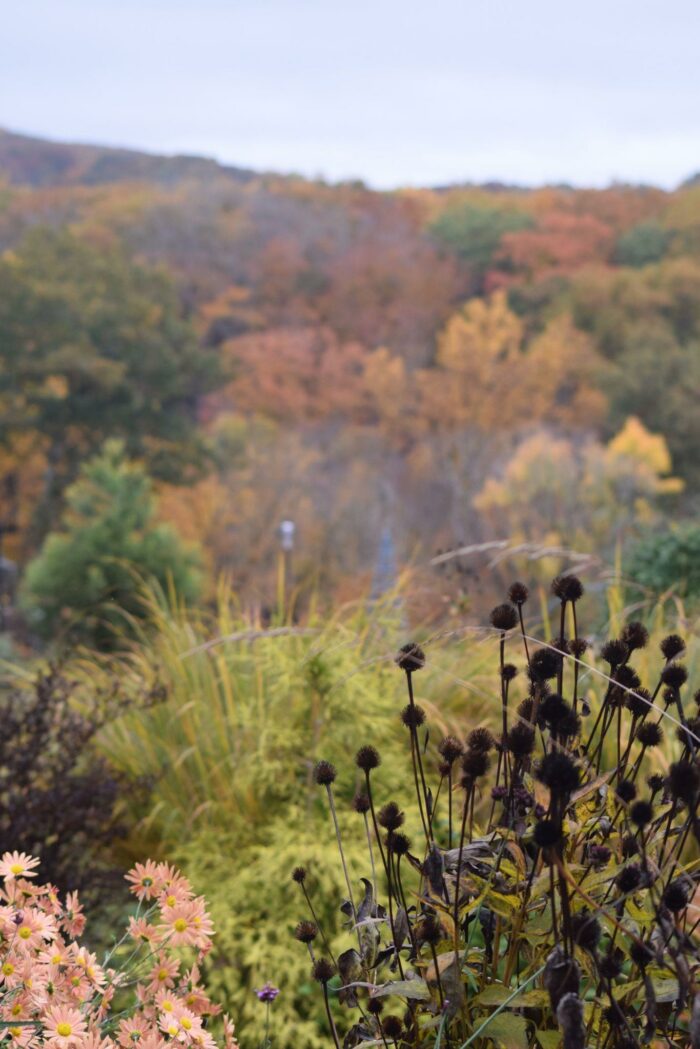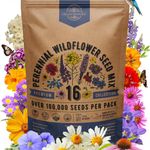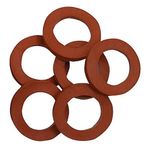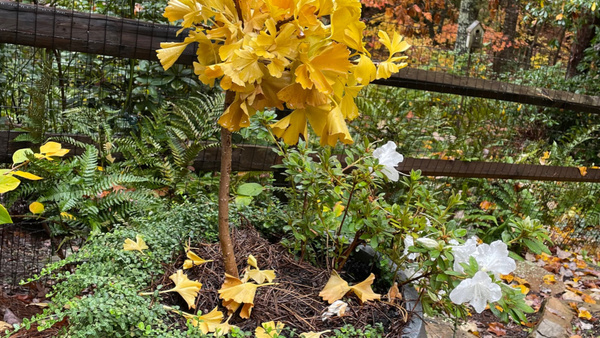Yesterday we visited Chad and Seyra’s garden in Woodbury, Connecticut, and today we’re back to see more of their beautiful plants.
Like a lot of other gardeners, we love the birds who come to our garden. Over the years, we have increasingly considered their needs when selecting new plants. But choosing coneflowers was a happy accident. We love Echinacea purpurea (Zones 3–8) because it is easy to grow, seeds itself around, blooms for months, comes in one of my favorite colors (pink), and just so happens to be popular with the birds and insects. It’s a total win-win! I like to mix them with other pink plants that have different shapes, like Pennisetum orientale ‘Karley Rose’ (Zones 5–8), and Sanguisorba hakusanensis ‘Lilac Squirrel’ (Zones 4–8).
Here’s one of those birds now. The goldfinches are just one of the many species who adore this plant!
The ponds and containers allow us to grow various water plants like lotus and water lilies. This miniature water lily, Nymphaea ‘Helvola’ (Zones 4–10) is perfectly proportional to the little froglet emerging from the small container that served as his nursery. Venture forth into the wide world, brave little one!
We also collect Brugmansia (Zones 8–10) because who could resist a Brug! We pack our basement to the ceiling with these behemoths every fall, knowing it’ll be totally worth it in the summer to have this!
This is Brugmansia ‘Charles Grimaldi.’ There’s something about lying on the grass underneath and gazing up into the fragrant trumpets that can erase your worries. These Brugs need lots of water and fertilizer and sturdy supports to stay happy and upright in their pots. Our yard is very windy, and these top-heavy pots often get knocked over unless we brace them with pieces of rebar. In this photo we are using a repurposed rebar plant support. Monty Don taught us that you can buy your own rebar and bend it to make your own sturdy supports. We bend it around the trunks of trees to shape them.
Every year we worry about the wildfires out west where our loved ones live. The smoke even drifts all the way out to Connecticut, sometimes making it hard to see the hills in the distance. But the smoke has a way of intensifying our sunsets like nothing else I’ve seen. These beautiful sunsets are so bittersweet.
In this photo, Rudbeckia fulgida (Zones 3–9) and Echinops bannaticus ‘Blue Glow’ (Zones 4–9) are backed by an intense sunset.
I could never say which season is my favorite, but fall has a special place in my heart. It’s as if fall is the garden’s grand finale thanking us for our hard work and bidding farewell until spring. We purposefully plant for fall colors. The native New England flora give us a head start with that. And we try to echo those colors in the garden.
We dug up our entire previous garden and brought it with us when we relocated. That first summer, we frantically planted things anywhere we could shoehorn them in to help the plants make it through their first winter. This photo shows that even in those early chaotic plantings, the plants found a way to find the right partners and shine anyway. I’m going to take that as proof of my theory that the more cool plants you collect, the higher probability that the plants will magically assemble themselves into a beautiful composition requiring no effort on the part of the gardener.
I am a huge fan of Patrinia scabiosifolia (Zones 5–8). It grows easily from seed, produces tall acid-yellow umbels beloved by pollinators, and has foliage that turns shades of red in the fall. What a workhorse of a plant! I’ll never be without it again. Behind it is Rudbeckia triloba (Zones 4–8). We rely heavily on self-seeding plants like these to fill in our empty spaces. We love the generosity of these plants. They give so much and ask nothing in return.
Check out more of this garden on Instagram: @s2szahme
Have a garden you’d like to share?
Have photos to share? We’d love to see your garden, a particular collection of plants you love, or a wonderful garden you had the chance to visit!
To submit, send 5-10 photos to [email protected] along with some information about the plants in the pictures and where you took the photos. We’d love to hear where you are located, how long you’ve been gardening, successes you are proud of, failures you learned from, hopes for the future, favorite plants, or funny stories from your garden.
Have a mobile phone? Tag your photos on Facebook, Instagram or Twitter with #FineGardening!
Do you receive the GPOD by email yet? Sign up here.
Fine Gardening Recommended Products
Organo Republic 16 Perennial Wildflower Seeds Mix for Indoor & Outdoors
Fine Gardening receives a commission for items purchased through links on this site, including Amazon Associates and other affiliate advertising programs.
Premium 16 Perennial Wildflower Seeds Mix - Special Garden Flower Seeds Blend designed for planting indoor & outdoors across North America. With over 16 varieties and 100,000 wildflower seeds, this mix is the best solution to attract pollinators - bees, butterflies & birds are essential for garden plants health. Our Special Perennial Wildflower Seeds Mix Includes White Yarrow, Columbine, New England Aster, Siberian Wallflower, Shasta Daisy, Lance-Leaf Coreopsis, Sweet William, Purple Coneflower, Blanketflower, Gayfeather, Blue Flax, Lupine, Dwarf Evening, Primrose, Mexican Hat, Prairie Coneflower, Black Eyed Susan. Easy & Fun Growing Experience with our online guides - Don’t plant disappointment - Add more colors to your wildflower garden! We send only super hearty heirloom flower seeds with the highest germination rate and fast sprout. Our detailed growing guide helps you grow seeds the garden of your dream like a PRO. Colorful Wildflower Garden from Seeds - Grow wildflowers everywhere - Indoor in window garden or Outdoors Flower garden Garden make a beautiful design for your garden borders, pathways, field or meadow and attract pollinators. Made in the USA by Small Family-Owned Business - Quality You Can Trust - Our wildflower bulk seeds variety pack are tested at the highest germination rates before being sealed to last for up to 3 years before you need to plant. Each packet of our flower seeds variety pack is resealable to make it easy to store and has its own label with a QR code for the growing instructions.
Berry & Bird Rabbiting Spade, Trenching Shovel
Fine Gardening receives a commission for items purchased through links on this site, including Amazon Associates and other affiliate advertising programs.
Ideal Tool for All Gardeners Use: Our heavy duty trenching shovel is designed by a professional gardening tool designer. Lifetime Durability: This heavy duty drain spade is made of high-quality stainless steel, it is very strong and durable, even if it is used for high-strength work, it will not bend. Ergonomic Wood Handle: The handle of this planting spade is made of ash hardwood harvested from FSC-certified forests and has an ergonomically streamlined design, making it very suitable for everyone's hands. Multi-Use: This digging shovel is generally used for digging trenches, digging holes, transplanting, edging, moving compost, cutting thick turf and furrowing. The sharp blade allows you to cut, scoop, dig, lift and dice in hard soil.
Gilmore Rubber Hose Washer 10pk
Fine Gardening receives a commission for items purchased through links on this site, including Amazon Associates and other affiliate advertising programs.
- Live red rubber construction, 3/4in. washers
- Clip of 10































Comments
What a beautiful setting you live in and I appreciate the hard work you have put into developing your garden. Gardeners are true optimists at heart and nurture the place wherever they land. So true in your case. I enjoyed yesterday’s posting and then got lost in your Instagram photos. In today’s posting I was intrigued by the photo with the Patrinia scabiosifolia which has all the characteristics of Verbena boneriensis, but completely different color profile. Thank you for sharing your garden with us.
Hi Angela. It's so nice how other gardeners can appreciate all the hard work that goes into a garden. You are so right about the Verbena bonariensis! Now I have to make sure to transplant Verbena seedlings in with the Patrinia next year. Thanks for such a great suggestion!
I've learned from you that a Brugmansia ‘Charles Grimaldi.’ can grow to an amazing size in such a small container, easy to move in non-hardy zones! Great news to learn!
I love love love your photos, especially the Purple Cone Flowers with the break in the clouds- I just had to save that to Pinterest.
Also I followed you on Plant Map. You are an inspiration to any gardener!
Thanks so much Sue. Oh, I forgot I even had a Plant Map account! I'll have to see what's there! If you don't have the space to bring in the whole brugmansia plant, I've heard others overwinter cuttings. They may need more time to bloom the following year because conventional wisdom is that they need to have a "Y" branch to bloom. So I try to overwinter the largest plants that I can so I can get blooms sooner in the growing season. I withhold water in the winter, so all the leaves drop and then I don't have to worry about pests on the foliage either.
Your love of gardening and nature shines through with every photo and description. Magnificent!!! I am in awe of the natural beauty you have brought together on your amazing property. Wow!!! Thank you for sharing your vision.
Thanks for your kind words Sheila!
Love!!!!!
Thank you!
Log in or create an account to post a comment.
Sign up Log in